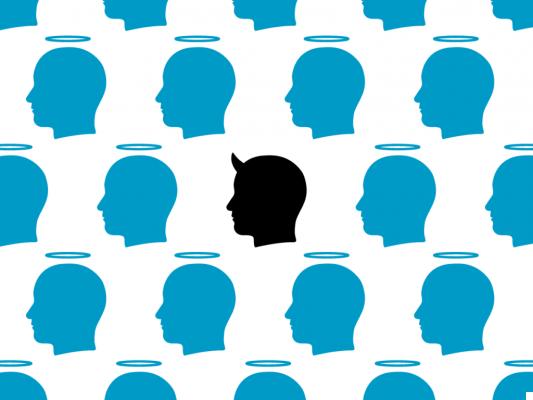
Nobody escapes prejudice. Whether we realize it or not, we always carry a backpack full of prejudices on our shoulders. Prejudices are nothing more than forming a judgment in advance about a person, group or event with little information available. Usually this process occurs below the threshold of consciousness and distorts our perception, making us react to the idea we have made, not to reality. The Horn Effect is one of the worst manifestations of these biases.
What is the Horn Effect?
The Horn effect is a cognitive bias that shows how a negative personality trait, behavior, or attitude obscures the rest of a person's or group's positive characteristics.
It consists of drawing conclusions about a person based solely on a trait, leading to a wrong generalization. That bias will affect how we perceive the person, to the point of clouding our judgment and determining our attitude.
Popular fantasy is full of examples of the Horn effect, such as thinking that all obese people are lazy or that blondes are stupid. In reality, sometimes prejudices are the result of our experiences, but in other cases they are culturally transmitted prejudices that encounter a cognitive resonance with our mental schemes.
Unfortunately, once the Horn effect sets in motion and we form an opinion of a person or group, it will be very difficult to change it. If we see something we don't like about a person, we will continue to attribute negative characteristics to him and judge him negatively. This will determine our attitude and behavior towards it, generating a self-fulfilling prophecy.
Who Discovered the Horn Effect?
The year was 1920, when psychologist Edward L Thorndike discovered a very curious phenomenon while carrying out his research in the military. He noticed that when soldiers discovered something positive in their superiors, they automatically began to attribute positive characteristics to him. He called this phenomenon Halo effect (Halo Effect).
As a result, he discovered that the opposite could also happen: when a superior did something negative he automatically turned into a detestable person. He called this phenomenon Effetto Horn (Horn Effect).
Later, psychologists Nisbett and Wilson delved into this phenomenon by recruiting 118 students from the University of Michigan. Each of them had to see a video in which the same teacher appeared, but in one of them the professor was kind and in the other he was authoritarian and unfriendly.
When they finished watching the videos, the researchers asked the students to describe the teacher's physical appearance. Students who saw the video in which the professor had a friendly attitude described him as a handsome man, while the others said he was an unattractive person. Of course, everyone thought their judgments were objective. They weren't aware that their perception was mediated by the Horn effect.
The mechanism of action of the Horn effect
The Horn effect is the result of thinking that negative traits are related to each other. In this way our judgment is influenced by negative and unfavorable perception. The Horn effect implies the activation of selective attention; that is, we focus only on one aspect and draw conclusions from this, forming a negative image of the person.
At the base there is also a dichotomous thinking, of the type "all or nothing", the idea that people are either good or bad. If we have a more flexible mind and understand that positive and negative coexist, we will be less likely to fall victim to the Horn effect.
However, it must be said that stereotypes are normal, they help us cope with information overload in complex environments and offer us a simple model of behavior. Stereotypes quickly offer us insights to enable us to react to new situations with a high degree of uncertainty. They are a kind of mental shortcut that allows us to decide quickly.
The problem starts when we are unable to move beyond the stereotype and this turns into a prejudice that people use to attribute some general characteristics based on skin color, religion, nationality or any other characteristic.
When we have prejudices about a person and we let ourselves be carried away by the first impression without offering him a "second chance" we are helping to consolidate our prejudices. If we assume that a person is unpleasant, we are likely to behave rudely towards them, so they will become defensive. So we validate, without realizing it, our prejudices.
How to avoid the Horn effect?
It is impossible to completely avoid prejudices, but we can make sure that they do not influence our behaviors, attitudes and decisions.
1. Develop more flexible thinking. If you develop a more open mind, understanding that no one is completely good or bad but we all have lights and shadows, you will be less likely to suffer the Horn effect because you will not have a tendency to link the negative traits together.
2. Analyze yourself. Reflect on the stereotypes that you carry with you, those that perhaps society has transmitted to you. Ask yourself how much truth is there in those beliefs and how much is due to erroneous generalizations that have nothing to do with you. It is also important that you analyze the biases that arise from your experiences. So you will understand that an isolated case cannot represent a whole group.
3. Don't rush. We live in a liquid world where we don't take the time to get to know and understand others. This implies that we are more likely to relate to each other starting from stereotypes and superficiality. One way to avoid the Horn Effect is to take the time to get to know each other. The first impression is important, no doubt, but looking beyond it is more rewarding because it will allow you to understand the complexity and richness that each person possesses.


























